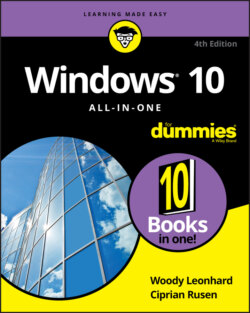Читать книгу Windows 10 All-in-One For Dummies - Ciprian Adrian Rusen, Woody Leonhard - Страница 103
What, Exactly, Is a Notification?
ОглавлениеHistorically, Windows allowed all sorts of notifications: blinking taskbar tiles, balloon messages over the system time (in the lower-right corner), dire-looking icons in the system notification area (near the system time), or dialog boxes that appear out of nowhere, sometimes taking over your computer. Then came Windows 8, and the powers that be started looking down on programs that jilted and cavorted, whittled and wheezed. People who write the programs have gradually become more disciplined.
Except for Scottrade, Figure 3-3, which locks out the screen, but that’s another modal dialog story.
These new, politically correct notifications — the things that can happen when Windows 10 or one of its programs wants your attention — fall into three broad categories:
They can put rectangular notices, usually gray, in the upper-right edge of your screen, with a few lines of text. Typically, the notifications say things such as Tap or Choose what happens when you insert a USB drive, or Turn sharing on or off.FIGURE 3-3: Scottrade’s notifications, generated by its web app, lock up the system entirely. Those are not nice notifications.These notifications are called toaster notifications (or sometimes just toast), and they’re a core part of the new Universal face of Windows 10. It’s a fabulous name because they pop up, just like toast, but on their sides, and then they disappear.
They can show toaster notifications on the lock screen. This is considered more dire than simply showing the notifications on tiled apps or the desktop. Why? Because the apps that create lock screen notifications may need to run, even when Windows 10 is sleeping. And that leads to battery drainage.
They can play sounds. Don’t get me started.
Everyone has picked up on Windows 10’s notification system. Even websites can now send you notifications when new content is posted. When an app sends you a notification, it appears briefly in the bottom-right corner of the screen. In Figure 3-4, you can see a notification about an email I’ve received.
FIGURE 3-4: A notification for an email I received.
When you click the notification — if you’re fast enough — it opens the email for you, and puts it in a separate window, ready for you to reply. That’s exactly the kind of response you should expect from your notifications — click them, and they do something appropriate. Some notifications display contextual options. For example, notifications from the Mail app have options for flagging, archiving, or dismissing an email you’ve received.
These notifications can be sent by apps, websites (through the web browser, when you’ve approved the receiving of notifications), and Windows 10 itself. As time goes by, more and more apps will be integrated with Windows 10’s action center.
